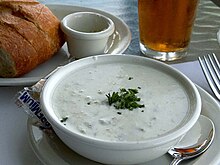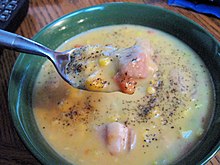Chowder
This article includes a list of general references, but it lacks sufficient corresponding inline citations. (June 2010) |


In North America Chowder is a generic name for a wide variety of seafood or vegetable stews and thickened soups, often with milk or cream and mostly eaten with saltines. Some varieties are traditionally thickened with crushed ship biscuit instead of flour, which is more usual. New England clam chowder - perhaps the best known chowder - is typically made with chopped clams and diced potatoes, in a mixed cream and milk base, often with a small amount of butter, it. Other common chowders include Manhattan clam chowder, which substitutes tomatoes for the milk and cream, and typically omits potatoes; Corn chowder ; a wide variety of fish chowders; and potato chowder, which is often made with cheese.
Origin of the term is obscure. One possible source is French chaudière, the type of pot in which the first chowders were probably cooked. (This, if true, would be similar to the origin of casserole - a generic name for a set of main courses originally prepared in a dish called a casserole.)[1]
The phonetic variant chowda, found in New England, is believed to have originated in Newfoundland in the days when Breton fisherman would throw portions of the day's catch into a large pot, along with other available foods.[1]
Fish chowder, corn and clam chowder, continue to enjoy popularity in New England and Atlantic Canada.
Types of chowder
See also
References
- ^ a b Hooker, Richard James (1978). The Book of Chowder. Harvard Common Press. p. 2. ISBN 0-916782-10-7.
- Wentworth, Harold; Flexner, Stuart Berg (1967). Dictionary of American Slang. New York: Thomas Y. Crowell. ISBN 0-690-23602-6.
"Chowderhead" definition, in use since c. 1835
- Edwards County Historical Society (1980). A History of Edwards County, Illinois. Vol. 1. Higginson Book Company. ISBN 0-88107-219-2.
{{cite book}}:|access-date=requires|url=(help)
